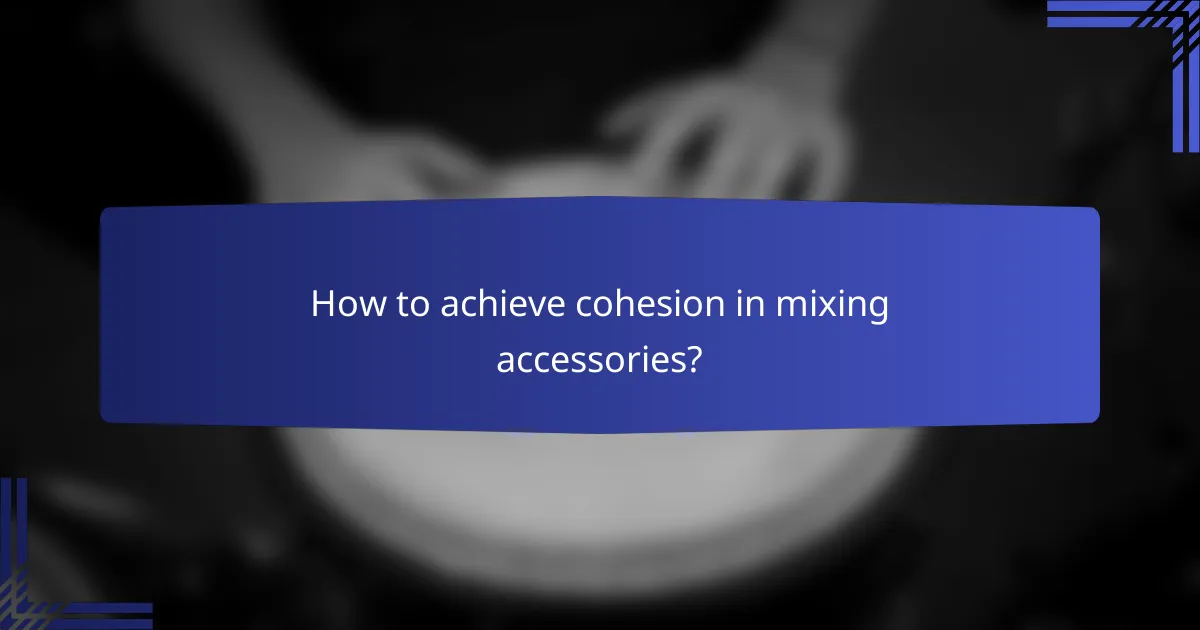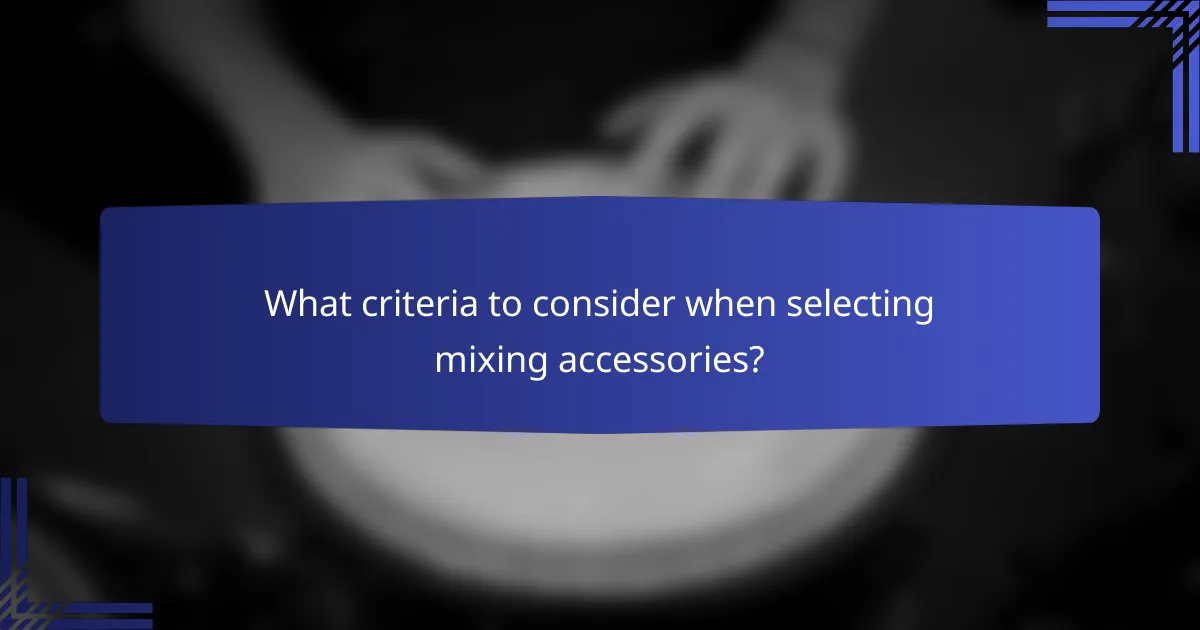Mixing accessories can elevate your style or space by creating a sense of cohesion, balance, and visual interest. By thoughtfully unifying elements through color, material, and style, you can achieve a harmonious look that feels intentional. Incorporating statement pieces and varied textures adds depth and flair, while careful consideration of size and weight ensures a balanced arrangement that captivates without overwhelming.

How to achieve cohesion in mixing accessories?
To achieve cohesion in mixing accessories, focus on unifying elements through color, material, and style. This ensures that your overall look feels intentional and harmonious rather than chaotic or mismatched.
Color matching techniques
Color matching is essential for creating a cohesive accessory ensemble. Start by selecting a color palette that includes a dominant color and one or two accent colors. For example, if your dominant color is navy, consider using gold and white as accents.
Utilize color theory principles, such as complementary or analogous colors, to guide your choices. A simple rule is to stick to three colors maximum to avoid overwhelming the visual impact.
Material compatibility
Material compatibility plays a crucial role in achieving cohesion. Mixing materials like leather, metal, and fabric can create interest, but ensure they complement each other. For instance, pairing a leather handbag with a metal bracelet can work well, while combining two heavy materials may feel bulky.
Consider the texture and finish of each material. A matte finish can contrast nicely with a shiny one, adding depth to your accessory mix. Aim for a balance that feels cohesive rather than random.
Style alignment
Style alignment ensures that your accessories reflect a consistent aesthetic. Whether your style is bohemian, classic, or modern, choose accessories that fit within that theme. For example, if you prefer a minimalist look, select simple, streamlined pieces that enhance rather than distract.
Be mindful of the occasion as well. Formal settings may require more refined accessories, while casual outings allow for playful combinations. Always consider how each piece contributes to the overall style narrative you wish to convey.

What are the best mixing accessories for visual interest?
The best mixing accessories for visual interest include statement jewelry pieces, textured fabrics, and layered decor items. These elements can enhance a space or outfit by adding depth, contrast, and a unique flair.
Statement jewelry pieces
Statement jewelry pieces are bold accessories that draw attention and can serve as focal points. They often feature unique designs, vibrant colors, or intricate details that elevate an outfit.
When selecting statement jewelry, consider the overall style of your attire. For instance, a chunky necklace can complement a simple dress, while oversized earrings can add drama to a casual look. Aim for one or two statement pieces to avoid overwhelming your ensemble.
Textured fabrics
Textured fabrics introduce visual interest through their tactile qualities and patterns. Materials like velvet, linen, or tweed can create contrast when mixed with smoother fabrics, enhancing the overall aesthetic.
In home decor, layering different textures can add depth to a room. For example, pair a soft velvet throw with a woven basket or a sleek leather sofa with knitted cushions. This combination creates a cozy yet sophisticated environment.
Layered decor items
Layered decor items involve stacking or grouping various accessories to create a visually appealing arrangement. This technique can be applied to shelves, tables, or walls, adding complexity and intrigue to your space.
To effectively layer decor, start with a larger item as a base, such as a vase or a stack of books, and build around it with smaller items like candles or framed photos. Aim for varying heights and shapes to maintain balance and visual interest.

How to balance mixing accessories effectively?
To balance mixing accessories effectively, consider the size, weight, and visual impact of each piece. A well-balanced arrangement enhances your overall look, creating cohesion and visual interest without overwhelming the viewer.
Proportional sizing
Proportional sizing involves selecting accessories that complement each other in scale. For example, pairing a large statement necklace with smaller earrings can create a balanced look. Aim for a mix where no single piece dominates the ensemble, typically keeping larger items to one or two in a collection.
When choosing accessories, consider the proportions of your outfit as well. If you wear a fitted dress, opt for more delicate accessories; with a voluminous outfit, larger accessories can provide balance.
Visual weight distribution
Visual weight distribution refers to how the eye perceives the heaviness of accessories. Heavier materials like metal or thick fabrics should be balanced with lighter items such as beads or fabrics. Distributing these weights evenly across your body can create a harmonious appearance.
For instance, if you wear a chunky bracelet on one wrist, consider wearing a lighter cuff or no bracelet on the other. This technique helps to avoid a lopsided look and maintains visual equilibrium.
Contrast and harmony
Contrast and harmony are essential for creating interest in your accessory mix. Use contrasting colors, textures, or styles to draw attention while ensuring that the overall look remains cohesive. For example, pairing a sleek leather bag with a soft, knitted scarf can create a pleasing contrast.
To achieve harmony, select accessories that share a common theme or color palette. This could mean using similar tones or materials across different pieces, which helps unify the overall look while still allowing for variation.

What criteria to consider when selecting mixing accessories?
When selecting mixing accessories, consider functionality, target audience preferences, and how these elements contribute to cohesion and visual interest. The right accessories enhance the mixing process while appealing to the intended users.
Functionality and purpose
Functionality is crucial when choosing mixing accessories, as each tool should serve a specific purpose in the mixing process. For example, a sturdy mixing bowl is essential for combining ingredients, while a whisk or mixer can improve texture and consistency. Assess the tasks at hand and select accessories that streamline these functions.
Consider the material of the accessories as well; stainless steel, glass, and silicone each have unique benefits. Stainless steel is durable and easy to clean, while glass allows for visual monitoring of the mixing process. Silicone tools are flexible and non-stick, making them ideal for scraping and folding.
Target audience preferences
Understanding the preferences of your target audience is vital for selecting mixing accessories that resonate with them. For instance, professional chefs may prefer high-end, durable tools, while home cooks might favor user-friendly and aesthetically pleasing options. Tailoring your selection to these preferences can enhance user satisfaction.
Additionally, consider the demographics and cooking styles of your audience. For example, a younger audience may appreciate trendy colors and designs, while a more mature audience might prioritize functionality and ease of use. Gathering feedback through surveys or focus groups can provide valuable insights into what your audience values most in mixing accessories.

What are the emerging trends in mixing accessories?
Emerging trends in mixing accessories focus on sustainability, personalization, and technology integration. These trends reflect a shift towards more thoughtful, unique, and functional designs that enhance both style and usability.
Sustainable materials
Sustainable materials are becoming increasingly popular in the accessory market. Consumers are seeking items made from recycled, organic, or ethically sourced materials, which not only reduce environmental impact but also promote a responsible lifestyle.
When selecting accessories, consider options like biodegradable plastics, reclaimed wood, or vegan leather. These materials often come with certifications that can help you make informed choices.
Personalized accessories
Personalized accessories allow individuals to express their unique identities and styles. Customization options, such as engraving or selecting specific colors and patterns, are gaining traction among consumers looking for one-of-a-kind pieces.
To effectively incorporate personalized accessories, consider items like monogrammed bags, custom jewelry, or tailored phone cases. These choices not only enhance personal style but also make great gifts that resonate with the recipient.
Tech-integrated designs
Tech-integrated designs are transforming traditional accessories by incorporating smart technology. Items like smartwatches, fitness trackers, and even tech-enabled handbags are examples of how functionality can blend with fashion.
When exploring tech-integrated accessories, look for features that enhance convenience, such as wireless charging capabilities or built-in health monitoring. Ensure that these items maintain aesthetic appeal while offering practical benefits.
